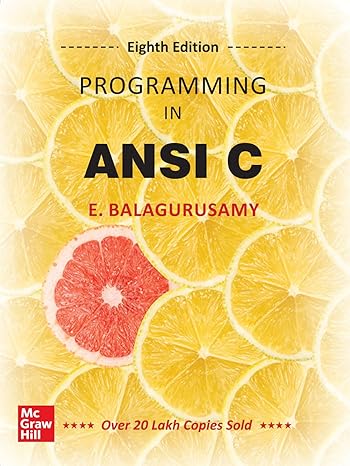Table of Content
- Important of C language programming and deep use
- Pointers
- Memory Management
- Structures and Unions
- Preprocessor Directives
- Error Handling
- Bitwise Operations
- Concurrency and Multithreading
- System Calls and Low-Level Programming
- Unique features of C Programming Language
- Pointer Arithmetic
- Undefined Behavior
- Preprocessor Directives
- Lack of Type Safety
- Manual Memory Management
- Direct Hardware Access
- Minimalistic Standard Library
- Function Pointers
- Array and Pointer Interchangeability
- Structure Padding and Alignment
- Historical Influence
- K&R vs. ANSI C
Why C language programming is important & unique features
C is a foundational programming language that has influenced many modern languages and has unique features and aspects that might not be widely known. Here are some intriguing and less commonly discussed aspects of C:
Important of C language programming and deep use
1. Pointers
Importance:- Pointers are a core element in C programming language that enable direct manipulation of memory. They provide the ability to access and modify data at specific memory addresses, which is crucial for performance and flexibility.
Deep use:
Dynamic Memory Management:- Pointers are used with functions like malloc, calloc, realloc, and free to manage memory dynamically, which is essential for creating data structures like linked lists, trees, and graphs.
Function Arguments:- Pointers are used to pass arguments by reference, allowing functions to modify the original data, which is efficient and avoids the overhead of copying large structures.
Pointer Arithmetic: This allows traversal and manipulation of arrays and buffers with arithmetic operations on pointer values, providing a powerful way to handle sequences of data.
2. Memory Management
Importance:- Manual memory management in C gives programmers control over how memory is allocated and freed, which can lead to optimized and efficient use of system resources.

Deep use:
Allocation and Deallocation:- Functions like malloc and free allow for dynamic memory allocation, which is necessary for managing memory in applications with variable data sizes.
Avoiding Memory Leaks:- Proper memory management practices are essential to avoid memory leaks, where allocated memory is not freed, leading to inefficient memory use and potential system crashes.

3. Structures and Unions
Importance:- Structures and unions are used to group different data types together, allowing the creation of complex data types that can model real-world entities.
Deep use:
Structures:- They enable the organization of related data under a single entity, which is useful for managing complex data in a modular way. For instance, you can define a struct to represent a Person with attributes such as name and age & address.
Unions:- They allow storing different data types in the same memory location, saving space when only one of several possible data types is needed at any given time. This is useful in scenarios where memory efficiency is crucial.
4. Preprocessor Directives
Importance:- Preprocessor directives provide a way to include files, define macros, and conditionally compile code, which can make programs more modular and manageable.
Deep use:-
Macros:- Macros defined with #define allow for code reuse and simplification by creating symbolic names for constants or expressions. File Inclusion: #include directives enable the inclusion of header files, which allows for modular programming and code separation.
Conditional Compilation:- Directives like #ifdef, #ifndef, and #if facilitate compiling code conditionally, which is useful for platform-specific code or for debugging.

5. Error Handling
Importance:- While C does not have built-in exception handling, error handling is critical for robust and reliable programs. C relies on error codes and status checks to manage errors.
Deep use:-
must check these codes to handle errors appropriately. Errno: The global variable errno holds error codes produced by system calls & library functions, facilitating detailed error reporting & management.
6. Bitwise Operations
Importance: Bitwise operations are used for low-level data manipulation, which is essential in systems programming and performance optimization.
Deep use:-
Flags and Masks:- Bitwise operations are used to set, clear, and toggle individual bits in flags, which is useful in scenarios like managing hardware registers or implementing efficient algorithms.
Efficient Data Storage:- Bitwise operations can pack multiple boolean flags or small data values into a single integer, saving space and increasing efficiency.
7. Concurrency and Multithreading
Importance:- While C does not have built-in support for concurrency, libraries and techniques for multithreading are crucial for developing modern, efficient applications.
Deep use:-
POSIX Threads (pthreads):- On Unix-like systems, the pthread library provides functions for creating and managing threads, enabling concurrent execution and improving program performance.
Synchronization:- Techniques such as mutexes and condition variables are used to manage access to shared resources and prevent race conditions in multithreaded applications.
8. System Calls and Low-Level Programming
Importance:- System calls is an act as the interface between operating system and application , allowing direct access to and interaction with operating system resources.
Deep use:-
File Operations:- C language programming in System calls like open, read, write, and close are used for file operations at a low level, providing control over file I/O beyond what the standard library offers.
Process Control: System calls such as fork and exec manage process creation and execution, which is fundamental for implementing complex applications and system utilities.

Unique features of C Programming Language
1. Pointer Arithmetic
C language programming allows for pointer arithmetic, which means you can perform operations directly on memory addresses. This feature provides great power and flexibility but requires careful handling to avoid errors such as buffer overflows.
2. Undefined Behavior
C has many situations where the behavior is "undefined," meaning that the language standard does not prescribe what should happen. This allows for highly optimized implementations but can also lead to unexpected results if the code is not carefully written.
3. Preprocessor Directives
The C preprocessor handles directives like #define, #include, and #ifdef. It performs textual substitution and file inclusion before the actual compilation starts. This mechanism allows for powerful macros and conditional compilation.
4. Lack of Type Safety
C language programming is not strongly typed, meaning you can perform operations on different types of data with fewer restrictions compared to languages like C++ or Java. This flexibility can lead to powerful programming techniques but also to potential bugs.
5. Manual Memory Management
Unlike languages with automatic garbage collection, C requires programmers to manually manage memory using malloc, calloc, realloc, and free. This gives more control but also increases the risk of memory leaks and segmentation faults.

6. Direct Hardware Access
C provides low-level access to hardware through pointers and bitwise operations. C is frequently utilized in systems programming, including the development of operating systems and embedded systems, due to its low-level capabilities and efficiency.
7. Minimalistic Standard Library
The C standard library is relatively small compared to libraries in higher-level languages. It provides essential functionalities like input/output operations, string manipulation, and mathematical computations but leaves more complex tasks to be implemented by the programmer or third-party libraries.
8. Function Pointers
C language programming provides support for function pointers, enabling you to store the addresses of functions in variables. This enables dynamic function calls and is useful in implementing callbacks, event handling, and plugin architectures.
9. Array and Pointer Interchangeability
In C, arrays & pointers are closely connected and frequently interchangeable. For example, when an array is passed to a function, it is effectively passing a pointer to the array's first element.
10. Structure Padding and Alignment
C compilers often add extra bytes between fields in a struct to align data in memory for performance reasons. This padding is compiler-specific and can vary between different systems and compilers.
11. Historical Influence
C was developed in the early 1970s and has influenced many other programming languages, including C++, C#, Java, and even Python. Its design and philosophy have had a lasting impact on software development.
12. K&R vs. ANSI C
The original version of C language programming, often referred to as K&R C after its authors Brian Kernighan and Dennis Ritchie, was later standardized as ANSI C (or C89/C90). The standardization introduced new features and improved portability.
13. Function in datatype
In C programming language printf & scanf are integral to input and output operations and can be used within functions to handle data.
Best Book to learn C
Recent Post
- Difference between narrow ai and general ai
- How AI is used in agriculture
- Janitor AI full details in depth with example
- What is the primary advantage of using generative ai in content creation
- ChatGPT features list, JBot, limitations, and benefits for you.
- The importance of computer networking & advantages of network

